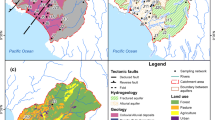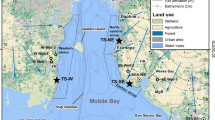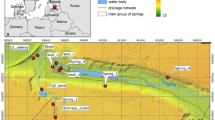Abstract
The European Union (EU) threshold values for \({\text{NH}}_{4}^{ + }\) in groundwater range from a minimum of 0.084 mg l−1 to the maximum allowed of 5 mg l−1. The aim of our study was to determine whether these values are adequate to protect groundwater copepods in alluvial aquifers underlying intensive agriculture. To this end, we analyzed abiotic (including \({\text{NH}}_{4}^{ + }\) concentration) and biological patterns (copepod assemblages) in an alluvial aquifer in an area of intensive agriculture. Groundwater was collected from pre-existing farmer-owned bores. Abiotic and biological patterns were not related to seasonal variation in agricultural practices, and pollutant concentrations were typically below the legal maximum threshold values. However, both abiotic and biological variables differed significantly between two groups of bores, with high and low \({\text{NH}}_{4}^{ + }\) conditions based on separate ecotoxicological assays that set the \({\text{NH}}_{4}^{ + }\) toxicity threshold for stygobiotic copepods at 2.5× below the current EU lowest legal threshold. In particular, phosphorus concentration was higher, and oxygen and copepod abundance and richness were lower in high \({\text{NH}}_{4}^{ + }\) bores. Our results suggest that the present threshold value range for \({\text{NH}}_{4}^{ + }\) adopted by EU Member States may not protect stygobiotic copepod assemblages in alluvial aquifers underlying densely cultivated areas.





Similar content being viewed by others
References
Aarset, V. & T. Aunaas, 1990. Effects of osmotic stress on oxygen consumption and ammonia excretion of the Arctic sympagic amphipod Gammarus wilkitzkii. Marine Ecology Progress Series 58: 217–224.
Anderson, M. J., R. N. Gorley & K. R. Clarke, 2008. PERMANOVA+ for PRIMER: Guide to Software and Statistical Methods. PRIMER–E Ltd, Plymouth.
Autorità di Bacino dell’Adige, 2008. Quaderno sul bilancio idrico superficiale di primo livello—Bacino idrografico del fiume Adige. A cura della Segreteria Tecnico Operativa. Trento, Maggio 2008. http://www.bacino-adige.it/sito/index.php?option=com_content&view=article&id=104&Itemid=324. Accessed 22 July 2014.
Blann, K. L., J. L. Anderson, G. R. Sands & B. Vondracek, 2009. Effects of agricultural drainage on aquatic ecosystems: a review. Critical Reviews in Environmental Science and Technology 39: 909–1001.
Boulton, A. J., G. Fenwick, P. J. Hancock & M. S. Harvey, 2008. Biodiversity, functional roles and ecosystem services of groundwater invertebrates. Invertebrate Systematics 22: 103–116.
Camargo, J. A. & A. Alonso, 2006. Ecological and toxicological effects of inorganic nitrogen pollution in aquatic ecosystems: a global assessment. Environment International 32: 831–849.
Camargo, J. A., A. Alonso & M. de la Puente, 2005. Eutrophication downstream from small reservoirs in mountain rivers of central Spain. Water Research 39: 3376–3384.
Candela, L., K. J. Wallis & R. M. Mateos, 2008. Non-point pollution of groundwater from agricultural activities in Mediterranean Spain: the Balearic Islands case study. Environmental Geology 54: 587–595.
Carpenter, S. R., N. F. Caraco, D. L. Corell, R. W. Howarth, A. N. Sharpley & V. H. Smith, 1998. Nonpoint pollution of surface waters with phosphorus and nitrogen. Ecological Applications 8: 559–568.
Caschetto, M., M. Barbieri, D. M. P. Galassi, L. Mastrorillo, S. Rusi, F. Stoch, A. Di Cioccio & M. Petitta, 2014. Human alteration of groundwater-surface water interactions (Sagittario River, Central Italy): implication for flow regime, contaminant fate and invertebrate response. Environmental Earth Sciences 71: 1791–1807.
Chen, J.-C., C.-T. Chen & S.-Y. Cheng, 1994. Nitrogen excretion and changes of hemocyanin, protein and free amino acid levels in the hemolymph of Penaeus monodon exposed to different concentrations of ambient ammonia-N at different salinity levels. Marine Ecology Progress Series 110: 85–94.
Cheng, S.-Y., L.-W. Shieh & J.-C. Chen, 2013. Changes in hemolymph oxyhemocyanin, acid-base balance, and electrolytes in Marsupenaeus japonicus under combined ammonia and nitrite stress. Aquatic Toxicology 130–131: 132–138.
Clarke, K. R., 1993. Non-parametric multivariate analyses of changes in community structure. Australian Journal of Ecology 18: 117–143.
Clarke, K. R. & R. N. Gorley, 2006. PRIMER v6: User Manual/Tutorial. PRIMER-E, Plymouth.
Clarke, K. R., J. P. Somerfield & N. G. Raymond, 2008. Testing of null hypotheses in exploratory community analyses: similarity profiles and biota-environment linkage. Journal of Experimental Marine Biology and Ecology 366: 56–69.
Colt, J. E. & D. A. Armstrong, 1981. Nitrogen toxicity to crustaceans, fish and molluscs. In: Allen, L. J & E. C. Kinney (eds), Proceedings of the Bio-Engineering Symposium for Fish Culture. Fish Culture Section, American Fisheries Society, Northeast Society of Conservation Engineers. Bethesda, Maryland: 34–47.
Dahan, O., A. Babad, N. Lazarovitch, E. E. Russak & D. Kurtzman, 2014. Nitrate leaching from intensive organic farms to groundwater. Hydrology and Earth System Sciences 18: 333–341.
Di Lorenzo, T. & D. M. P. Galassi, 2013. Agricultural impact in Mediterranean alluvial aquifers: do groundwater communities respond? Fundamental and Applied Limnology 182: 271–282.
Di Lorenzo, T., M. Brilli, D. Del Tosto, D. M. P. Galassi & M. Petitta, 2012. Nitrate source and fate at the catchment scale of the Vibrata River and aquifer (central Italy): an analysis by integrating component approaches and nitrogen isotopes. Environmental Earth Sciences 67: 2383–2398.
Di Lorenzo, T., F. Stoch & D. M. P. Galassi, 2013. Incorporating the hyporheic zone within the river discontinuum: longitudinal patterns of subsurface copepod assemblages in an Alpine stream. Limnologica 43: 288–296.
Di Lorenzo, T., W. D. Di Marzio, M. E. Sáenz, M. Baratti, A. A. Dedonno, A. Iannucci, S. Cannicci, G. Messana & D. M. P. Galassi, 2014. Sensitivity of hypogean and epigean freshwater copepods to agricultural pollutants. Environmental Science and Pollution Research 21: 4643–4655.
Di Marzio, W. D., D. Castaldo, T. Di Lorenzo, A. Di Cioccio, M. E. Sáenz & D. M. P. Galassi, 2013. Developmental endpoints of chronic exposure to suspected endocrine-disrupting chemicals on benthic and hyporheic freshwater copepods. Ecotoxicology and Environmental Safety 96: 86–92.
Distretto Idrografico delle Alpi Orientali, 2010. Piano di Gestione delle Acque. http://www.alpiorientali.it/new/index.php/direttiva-2000-60/piano-di-gestione-acque-2009-2015/documenti-preliminari-h2o. Accessed 22 July 2014.
Dole-Olivier, M.-J., D. M. P. Galassi, P. Marmonier & M. Creuzé des Chatelliers, 2000. The biology and ecology of lotic microcrustaceans. Freshwater Biology 44: 63–91.
Dumas, P., 2004. Irrigation as a disturbance for interstitial crustacean communities in a French Pyrenean alluvial aquifer. International Journal of Limnology 40: 139–147.
Erisman, J. W., A. Bleeker, J. Galloway & M. S. Sutton, 2007. Reduced nitrogen in ecology and the environment. Environmental Pollution 150: 140–149.
European Commission, 2006. Directive 2006/118/EC of the European Parliament and of the Council of 12 December 2006 on the protection of groundwater against pollution and deterioration. Official Journal of the European Union L 372/19.
European Commission, 2010. Commission Staff Working Document accompanying the Report from the Commission in accordance with Article 3.7 of the Groundwater Directive 2006/118/EC on the establishment of groundwater threshold values Brussels, SEC(2010) 166 final.
European Union, 2012. Statistical and Economic Information. Report 2012. Directorate-General for Agriculture and Rural Development. http://ec.europa.eu/agriculture/statistics/agricultural/2012/pdf/full-report_en.pdf.
Fiasca, B., F. Stoch, M.-J. Olivier, C. Maazouzi, M. Petitta, A. Di Cioccio & D. M. P. Galassi, 2014. The dark side of springs: What drives small-scale spatial patterns of subsurface meiofaunal assemblages? Journal of Limnology 73: 55–64.
Galassi, D. M. P., 2001. Groundwater copepods (Crustacea: Copepoda): diversity patterns over ecological and evolutionary scales. Hydrobiologia 453(454): 227–253.
Galassi, D. M. P., R. Huys & J. W. Reid, 2009. Diversity, ecology and evolution of groundwater copepods. Freshwater Biology 54: 691–708.
Gibert, J., D. L. Danielopol & J. A. Stanford (eds), 1994. Groundwater Ecology. Academic Press, San Diego.
Griebler, C., F. Malard & T. Lefébure, 2014. Current developments in groundwater ecology—from biodiversity to ecosystem function and services. Current Opinion in Biotechnology 27: 159–167.
Hahn, H. J. & D. Matzke, 2005. A comparison of stygofauna communities inside and outside groundwater bores. Limnologica 35: 31–44.
Hahn, H. J. & A. Fuchs, 2008. Distribution patterns of groundwater communities across aquifer types in southwestern Germany. Freshwater Biology 54: 848–860.
Hartland, A., G. D. Fenwick & S. J. Bury, 2011. Tracing sewage-derived organic matter into a shallow groundwater food web using stable isotope and fluorescence signatures. Marine and Freshwater Research 62: 119–129.
Hurlbert, S. H., 1984. Pseudoreplication and the design of ecological field experiments. Ecological Monographs 54: 187–192.
ISTAT, 2006. Agricoltura. Fertilizzanti distribuiti, per tipo di produzione, stato, utilizzo consentito in agricoltura in quintali, allo stadio solido. Dettaglio per Provincia. Anno 2006. http://www3.istat.it/dati/catalogo/20061109_00/PDF/cap13.pdf. Accessed 22 July 2014.
Jensen, F. B., 1995. Uptake and effects of nitrite and nitrate in animals. In Walsh, P. J. & P. Wright (eds), Nitrogen Metabolism and Excretion. CRC Press, Boca Raton: 289–303.
Jensen, F. B., 2003. Nitrite disrupts multiple physiological functions in aquatic animals. Comparative Biochemistry and Physiology, Part A 135: 9–24.
Jiao, J. J., Y. Wang, J. A. Cherry, X. Wang, B. Zhi, H. Du & D. Wen, 2010. Abnormally high ammonium of natural origin in a coastal aquifer-aquitard system in the Pearl River Delta, China. Environmental Science and Technology 44: 7470–7475.
Korbel, K. L., P. J. Hancock, P. Serov, R. P. Lim & G. C. Hose, 2013. Groundwater ecosystems vary with land use across a mixed agricultural landscape. Journal of Environmental Quality 42: 380–390.
Kota, S., R. C. Borden & M. A. Barlaz, 1999. Influence of protozoan grazing on contaminant biodegradation. Federation of European Microbiological Societies Microbiology Ecology 29: 179–189.
Marshall, M. C. & R. O. Hall, 2004. Hyporheic invertebrates affect nitrogen cycling and respiration in stream sediment microcosms. Journal of the North American Benthological Society 23: 416–428.
McGarvey, J. A., W. G. Miller, R. Zhang, Y. Ma & F. Mitloehner, 2007. Bacterial population dynamics in diary waste during aerobic and anaerobic treatment and subsequent storage. Applied and Environmental Microbiology 73: 193–202.
Melo, A., E. Pinto, A. Aguiar, C. Mansilha, O. Pinho & I. Ferreira, 2012. Impact of intensive horticulture practices on groundwater content of nitrates, sodium, potassium, and pesticides. Environmental Monitoring and Assessment 184: 4539–4551.
Morari, F., E. Lugato, R. Polese, A. Berti & L. Giardini, 2012. Nitrate concentrations in groundwater under contrasting agricultural management practices in the low plains of Italy. Agriculture, Ecosystems & Environment 147: 47–56.
Mosier, A. R., J. K. Syers & J. R. Freney, 2004. Agriculture and the nitrogen cycle: assessing the impacts of fertilizer use on food production and the environment. Island Press, Washington, DC.
Poch-Massegu, R., J. Jimenez-Martinez, K. J. Wallis, F. Ramirez de Cartagena & L. Candela, 2014. Irrigation return flow and nitrate leaching under different crops and irrigation methods in Western Mediterranean weather conditions. Agricultural Water Management 134: 1–13.
R Development Core Team, 2008. A language and environment for statistical computing. R Foundation for Statistical Computing, Vienna, Austria. http://www.R-project.org. Accessed 22 July 2014.
Raave, H., I. Keres, K. Kauer, M. Nõges, J. Rebane, M. Tampere & E. Loit, 2014. The impact of activated carbon on NO3 −-N, NH4 +-N, P, K leaching in relation to fertilizer use. European Journal of Soil Science 65: 120–127.
Repubblica Italiana, 2009. Decreto Legislativo 16 Marzo 2009, n. 30: Attuazione della direttiva 2006/118/CE, relativa alla protezione delle acque sotterranee dall’inquinamento e dal deterioramento. Gazzetta Ufficiale 79.
Romano, N. & C. Zeng, 2013. Toxic effects of ammonia, nitrite, and nitrate to decapod crustaceans: a review on factors influencing their toxicity, physiological consequences, and coping mechanisms. Reviews in Fisheries Science 21: 1–21.
Rouch, R., A. Pitzalis & A. Descouens, 1993. Effets d’un pompage à gros débit sur le peuplement des crustacés d’un aquifère karstique. Annales de Limnologie 29: 15–29.
Schmidt, S. I., H. J. Hahn, T. J. Hatton & W. F. Humphreys, 2007. Do faunal assemblages reflect the exchange intensity in groundwater zones? Hydrobiologia 583: 1–19.
Sharma, B. & R. C. Ahlert, 1977. Nitrification and nitrogen removal. Water Research 11: 897–925.
Sket, B., 1999. The nature of biodiversity in hypogean waters and how it is endangered. Biodiversity and Conservation 8: 1319–1338.
Stein, H., C. Kellermann, S. I. Schmidt, H. Brielmann, C. Steube, S. E. Berkhoff, A. Fuchs, H. J. Hahn, B. Thulin & C. Griebler, 2010. The potential use of fauna and bacteria as ecological indicators for the assessment of groundwater quality. Journal of Environmental Monitoring 12: 242–254.
Stoch, F. & D. M. P. Galassi, 2010. Stygobiotic crustacean species richness: a question of numbers, a matter of scale. Hydrobiologia 653: 217–234.
Tilman, D., 1999. Global environmental impacts of agricultural expansion: the need for sustainable and efficient practices. PNAS 96: 5995–6000.
van Grinsven, H. J. M., H. F. M. ten Berge, T. Dalgaard, B. Fraters, P. Durand, A. Hart, G. Hofman, B. H. Jacobsen, S. T. J. Lalor, J. P. Lesschen, B. Osterburg, K. G. Richards, A.-K. Techen, F. Vertès, J. Webb & W. J. Willems, 2012. Management, regulation and environmental impacts of nitrogen fertilization in northwestern Europe under the Nitrates Directive; a benchmark study. Biogeoscience 9: 5143–5160.
Weihrauch, D., J. C. McNamara, D. W. Towle & H. Onken, 2004. Ion-motive ATPases and active transbranchial NaCl uptake in the red freshwater crab Dilocarcinus pagei (Decapoda Trichodactylidae). Journal of Experimental Zoology 207: 4623–4631.
Wood, P. J., J. Gunn & S. D. Rundle, 2008. Response of benthic cave invertebrates to organic pollution events. Aquatic Conservation 18: 909–922.
Acknowledgements
The project was funded by a grant from the Basin Authority of the River Adige (Trento, Italy). We thank Fabio Lazzeri for the design and concept of Fig. 1, and Andrea Marchetti and Enrico Gattone for help in field sampling. Constructive criticism by Dr. Grant C. Hose (Macquarie University, NSW, Australia) and an anonymous reviewer also improved the paper.
Author information
Authors and Affiliations
Corresponding author
Additional information
Handling editor: Diego Fontaneto
Electronic supplementary material
Below is the link to the electronic supplementary material.
Rights and permissions
About this article
Cite this article
Di Lorenzo, T., Cifoni, M., Lombardo, P. et al. Ammonium threshold values for groundwater quality in the EU may not protect groundwater fauna: evidence from an alluvial aquifer in Italy. Hydrobiologia 743, 139–150 (2015). https://doi.org/10.1007/s10750-014-2018-y
Received:
Revised:
Accepted:
Published:
Issue Date:
DOI: https://doi.org/10.1007/s10750-014-2018-y




